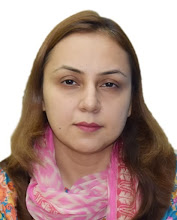Chapter 26: Design for Inclusion - Exploring Intersectionality
Date/Time: 10th Sep 2024 Tuesday , 4:10 pm
Sharing another very intriguing and interesting concept I learned from the ISTE Course online "Designing for Inclusion". Now to be honest the term "intersectionality" was new for me and I could not figure out what it actually means. I explored the content in the second module of the course, watched additional videos on YouTube and explored on the web. It took time but I think the exercise was worth it. As far as my understanding of the term intersectionality is concerned, it has something to do with our identities that are continually reshaped by our interactions with the various elements in the environment. These elements can be you relate to in family, friends, workplaces etc, this can also include the varying mindsets of the community, it can be related to norms a community sets for women and men, it can relate to your gender, skin colour, ethnicity, religion , physical appearance or any disability that ends up impacting you in a negative way, or causing a disadvantage as compared to other individuals in the society.
I was awestruck and inspired by a TED Talk by the professor Kimberle' Crenshaw and the way she explained the concept of intersectionality using real life examples related to African American Black women. In her talk she fought for the rights of black women in their society who were killed or murdered or harmed for being black women and a woman. She shared an example of a case where a woman was at the intersection of multiple factors that lead to her unemployment but the judge in that case could not see that somehow. She used a road and traffic analogy to explain the concept of intersectionality.
And after skimming and researching I thought of doing a little activity on the Google Jam board. I started typing on sticky notes of the effects of people, decisions, environment, family , friends, workplace etc while I wrote my name in the centre. It was a huge relief.
I could clearly see myself in a storm! in the midst of chaos! And I was there standing firm. There seemed to be so much going around me.
I could see the emotional factors shaping a different identity
I could also see the effects of a non trusting relationship with people known creating a different identify
I could see the impact of a harsh environment biased, judgemental , gender discrimination creating a different identity
I could see financial constraints at times creating a new identity
I could see health factors creating a different identity.
And finally I was able to write who I am and what I enjoy doing the most.
I framed my own identity that way I see myself, happy and joyful.
This was a really good exercise.
Now the important question:
How many of us see ourselves with this window? angle?perspectives?calmness? kindness?.
How many of us know that our interactions with the environment and objects in the environment shape and create our identities?
How many of us wonder about the students in our classes? What are their identities?
How many of us as employers focus on the several identities of an employee while hiring?
How many of the employees think of these multiple identities of an individual while asking them to quit from the job?
How many companies conduct surveys about intersectionality?
How many people actually know about this term in our surroundings ? at home? At the workplace?
Do we teach this concept in schools? colleges or universities? in Pakistan?
How many men or women or students might have suffered because of intersectionality?
How can we create awareness about such important concepts?
To be honest, knowing about intersectionality and the various elements in the environment that affect our personalities, create different personalities, affect behaviour and emotions, can positively affect decision making leading to enhanced outcomes. We may be in a much better position to understand and comprehend the challenges we all face in our lives. This may also help us become more wise humans. This may also develop empathy towards each other. This may also help us see the different sides of an individual.
I would completely agree with Professor Kimberle' Crenshaw who says we cannot question the outcomes without knowing what caused them. Imagine the insight we would have once we know the reasons behind the outcomes!
Enjoy Reading!
Regards and prayers
Sheeba Ajmal

Comments
Post a Comment